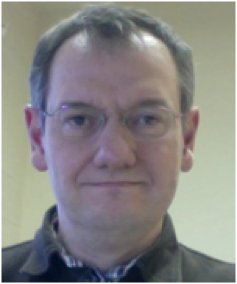| Important Dates: | |
|---|---|
| Application opens: | February 15, 2012 |
| Application closes: | April 2, 2012 |
| Notification of acceptance: | April 10, 2012 |
| Deadline for payment of registration: | May 1, 2012 |
| Arrival of participants: | July 15, 2012 |
| Start of event: | July 16, 2012 |
| End of event: | July 21, 2012 |
Second European Business Intelligence Summer School (eBISS 2012)
Invited Speakers & Tutors
-

Nesrine Ben Mustapha
Ecole Centrale de Paris, FranceNesrine Ben Mustapha obtained her master degree in computer science from ENSI (Ecole Nationale des Sciences de l'informatique) of Tunis in 2007. She is finishing her PhD in March 2012 and she will continue to carry out postdoctoral research in Ecole Centrale Paris (MAS Laboratory) in the context of an EU funded project. Her research interests include ontology learning from texts, machine learning applied to texts and ontology-based semantic search.
Email: nesrine.ben-mustapha@ecp.fr
Web: https://sites.google.com/site/nesrinebenmustaphapageperso/
Lecture: Harvesting Knowledge for Business Intelligence
With the growth rate of information volume, information access and knowledge management in enterprises has become challenging. This lecture aims to describe the importance of semantic technologies (ontologies) and knowledge extraction techniques for knowledge management, search and capture in e-business processes. We will present a state of the art of ontology learning approaches from textual data and web environment and their integration in enterprise systems to perform personalized and incremental knowledge harvesting. -

Gianluca Bontempi
Université Libre de Bruxelles, BelgiumGianluca Bontempi graduated with honors in Electronic Engineering (Politecnico of Milan, Italy) and obtained his PhD in Applied Sciences (ULB, Brussels, Belgium). He took part to research projects in academy and private companies all over Europe. His interests cover data mining, machine learning, bioinformatics, time series prediction and simulation. He is author of more than 100 scientific publications. He is also co-author of software for data mining, bioinformatics and prediction which was awarded in two international competitions. From January 2002 he is Professor in Computer Science in ULB Brussels and from 2004 he is the Head of the ULB Machine Learning Group.
Email: gbonte@ulb.ac.be
Web: http://www.ulb.ac.be/di/map/gbonte/Welcome.html
Lecture: Computational Intelligence Methods for Time Series Prediction
Reliable and accurate prediction of time series is a major issue in several applied domains (e.g. finance, logistics, marketing, energy) and requires intelligent methods to infer models from observed data. The course will first present some basic notions of statistical machine learning for selecting and assessing prediction models from real temporal data. Then an introduction to linear and nonlinear algorithms for prediction will be made. Finally, we will discuss a number of strategies for accurate prediction over long term horizons which is considered the current frontier of forecasting. -

Yves De Smet
Université Libre de Bruxelles, BelgiumYves De Smet holds a degree in Mathematics (1998) and a PhD in Applied Sciences (2005). He is head of the Computer and Decision Engineering department (CoDE) of the Université Libre de Bruxelles (ULB). He teaches courses about probability and statistics, operational research and decision engineering. His research interests are mainly focused on multicriteria decision aid: theoretical properties, methodological developments, and applications. He is also regularly involved in industrial projects. Since February 2010, he is co-founder of the D-Sight Spin-off.
Email: yves.de.smet@ulb.ac.be
Web: http://code.ulb.ac.be/~yvdesmet/
Lecture: An Introduction to Multicriteria Decision Aid: The PROMETHEE and GAIA Methods
Most strategic decision problems involve the evaluation of potential solutions according to multiple conflicting criteria. The aim of this talk is to introduce the basics of Multicriteria Decision Aid (MCDA) with a special emphasis on the PROMETHEE & GAIA methods. First, practical examples will be provided to illustrate the distinctive features of this research area. Then, traditional modeling issues will be addressed. The main part of the presentation will be dedicated to explain in detail the PROMETHEE methodology. Finally, a case study will be analyzed with the D-Sight software. This will highlight the added value of using interactive and visual tools in complex decision processes. -

Christophe Debruyne
Vrije Universiteit Brussel, BelgiumChristophe Debruyne is a junior researcher at the Semantics Technology and Applications Research Laboratory at the Vrije Universiteit Brussel, Belgium. His research focuses on the role of natural language descriptions and social processes in ontology engineering methodologies. He holds a MSc in Computer Science from the Vrije Universiteit Brussel. He is member of IFIP Working Group 12.7 Social Networking Semantics and Collective Intelligence.
Email: chrdebru@vub.ac.be
Web: http://www.christophedebruyne.be/

Pieter De Leenheer
Collibra, Belgium
VU University Amsterdam, The NetherlandsPieter De Leenheer is cofounder and codirector of Collibra nv/sa. He is also assistant professor of Information and Service Sciences at VU University Amsterdam. Pieter holds a PhD in Computer Science from the Vrije Universiteit Brussel (2009). Pieter is the key co-designer of the principles and methods underpinning Collibra's semantic information governance technologies. His research focuses on social processes in collaborative ontology engineering and dynamic composition of service value networks. Pieter is vice-chair of the IFIP Working Group 12.7 Social Networking Semantics and Collective Intelligence and is member of IEEE and ACM.
Email: pieter@collibra.com
Web: http://www.pieterdeleenheer.be
Lecture: Insights in Business Semantics Management with Case studies from the Flanders Research Information Space Program
Knowledge management methodologies try to capture the descriptions of business entities in terms of their attributes and relations with other business entities. When those descriptions are needed for interoperability tasks between two or more autonomously developed information systems or for reasoning tasks, those descriptions are often captured in a shared formal specification called an ontology. We present Business Semantics Management (BSM) method, a fact-oriented approach to knowledge modeling grounded in natural language. We first show how fact-oriented approaches differ from approaches in terms of, amongst others, expressiveness, complexity, and decidability and how this formalism is easier for users to render their knowledge. We then explain the different processes in BSM and how the tool suite supports those processes. Finally, we show how the ontologies can be transformed into other formalisms suitable for particular interoperability tasks. All the processes and examples will be taken from industry cases throughout the lecture. -

Jean-Daniel Fekete
INRIA, FranceJean-Daniel Fekete is a Senior Research Scientist at INRIA, one of the leading French national research centers, located in Orsay in the University Paris-Sud. He leads the AVIZ team since 2007, which focuses on Visual Analytics. AVIZ studies the analysis and visualization of large datasets, combining machine learning approaches with information visualization and multiscale interaction techniques to help analysts explore and understand massive data. Jean-Daniel's research topics include network visualization, evaluation of information visualization systems, and toolkits for user interfaces and information visualization. His research is applied in several fields such as biology, business intelligence and social network analysis.
Email: Jean-Daniel.Fekete@inria.fr
Web: http://www.lri.fr/~fekete/
Lecture: Visualizing and Exploring Complex Multidimensional Data
At several crucial steps of the BI process, humans have to make decisions: they need to understand complex information and data extracted from large databases and produced by complex analytical processes. Information Visualization aims at showing that wealth of data in a meaningful way. Visual Analytics goes a step further by tightly coupling the analytical loop with the visualization loop to allow exploratory analysis and visualization. Building effective visualization and interaction techniques is hard because it relies on well understood psychological mechanisms that are not generative: empirical studies are needed to verify the effectiveness of the techniques and we will describe what works and what does not (despite being trendy and cool sometimes). Combining visualization and analysis is an even bigger challenge that requires new analytical algorithms and special software infrastructures to support interactive-time explorations that scale. We will describe some of the techniques and challenges in this new area. -

Torben Bach Pedersen
Aalborg University, DenmarkTorben Bach Pedersen is a full professor of computer science at Aalborg University (AAU), Denmark, where he heads the Center for Data-Intensive Systems (Daisy). He received his Ph.D. in computer science from AAU in 2000 and his M.Sc. in computer science and mathematics from Aarhus University in 1994. Before joining AAU in 2000, he worked as a business intelligence specialist in industry for six years. His research interests span business intelligence topics such as data warehousing, OLAP, and data mining, with a focus on non-traditional and complex types of data such as web-related data, spatial and spatio-temporal data, music data, energy data, and medical data. He has published more than 100 peer-reviewed papers on these topics. He has served as PC Chair for DaWaK 2009 and 2010 and DOLAP 2010, General Chair for SSTD 2009, and on numerous program committees, including VLDB, ICDE, and EDBT. He is a member of the SSTD Endowment and the DOLAP Steering Committee.
Email: tbp@cs.aau.dk
Web: http://people.cs.aau.dk/~tbp/
Lecture: Managing Complex Multidimensional Data
Multidimensional database concepts such as cubes, dimensions with hierarchies, and measures are a cornerstone of business intelligence. However, the standard data models and system implementations (OLAP) for multidimensional databases are sometimes not able to capture the complexities of advanced real-world application domains. This lecture will focus on how to manage such complex multidimensional data, including complex dimension hierarchies, complex measures, and integration of multidimensional data with complex external data. We will look at how complex multidimensional data emerge in complex application domains such as medical data, location-based services, energy data, music data, web data, and text data, and present solutions for these domains that support multidimensional business intelligence. -

Michael Saecker
Technische Universität Berlin, GermanyMichael Saecker is a research associate at the Database Systems and Information Management (DIMA) group at the Technische Universität Berlin, Germany. He joined DIMA in June 2010 after he obtained his diploma in Computer Science from TU Berlin. His research interests include query processing on graphics adapters, parallelization of queries and query optimization. Michael is currently working on a BMWi-funded project together with an SME in Cologne, with the goal to build a big data analytics engine that efficiently exploits new hardware architectures, in particular graphics processing units (GPUs).
Email: michael.saecker@tu-berlin.de
Web: http://www.dima.tu-berlin.de/menue/mitarbeiter/michael_saecker/parameter/en/
Lecture: Big Data Analytics on Modern Hardware Architectures
Big data analytics has the goal to analyze massive datasets, often in the Terabyte or even Petabyte scale, which increasingly occur in web-scale business intelligence problems. Today, many different hardware architectures apart from traditional CPUs can be used to process data. GPUs or FPGAs, among other new hardware, are usually employed as co-processors to accelerate query execution. The common point of these architectures is their massive inherent parallelism as well as a different programming model (single instruction, multiple data) compared to classical von-Neumann CPUs. This lecture introduces big data analytics and typical applications. It then describes several architectures for hardware supported parallel processing, discusses research and commercial systems for big data analytics and describes the underlying query processing algorithms. -

Sabri Skhiri
Euranova, BelgiumSabri Skhiri leads the Euranova R&D department by defining the research areas of the company. He manages internal research projects, back office R&D requests, technological watch for customers, technical assessments and innovation forums within Euranova. His researches focus on distributed computing and data, high performance computing architectures and new paradigms, modeling and governance modeling. In addition, as a Euranova expert consultant, Sabri leads the European R&D Architecture Department in the Carrier-Software division of Huawei technologies, a Telecom Chinese multi-national company. In this context, he leads different R&D projects around cloud architecture, Service delivery platform, Social graphs and model-driven development. He started his career as a researcher at the Université of Bruxelles. Then he worked at Alcatel-Lucent where he has been working as R&D project manager. He was responsible for IDE and modeling project, the design of the next generation of Telecom Application Server, a massive multi-player platform project and the common data management strategy between different high performance platforms.
Email: sabri.skhiri@euranova.eu
Web: http://www.euranova.eu
Lecture: Large Graph Data Mining and Data Warehousing
With the recent growth of the graph-based data, the large graph processing becomes more and more important. In order to explore and to extract knowledge from such data, graph mining methods, like community detection, is a necessity. Although the graph mining is a relatively recent development in the Data Mining domain, it has been studied very intensively under different guises (biology, social networks, telecommunications and Internet). The legacy graph processing tools mainly rely on single machine computational capacity, which cannot process large graph with billions of nodes. Therefore, the main challenge of new tools and frameworks lies on the development of new paradigms that are scalable, efficient and flexible. In this course, we will review the new paradigms of large graph processing and their applications to graph mining domain. The course will be organised as a walk through different industrial needs in terms of graph mining passing by the existing solutions. Finally, we will expose a set of open research questions fitted with some new business requirements such us the graph data warehouse and the modelling evolution required to design this new generation of data mart. -

Marcus Spies
Ludwig-Maximilians University, GermanyMarcus Spies holds a Ph.D. and a habilitation in cognitive science. From 1989-1995, he was research staff member at IBM working on statistical expert systems and speech recognition. In 1996, he became senior technical consultantat IBM and led several large engagements covering intermodal logistics business process automation and security architectures for financial service providers. In 2000, Marcus was appointed professor of knowledge management at LMU University of Munich. His chair is combining research from the departments of computer science, business informatics and learning sciences. He supervised numerous master and doctoral theses on knowledge management strategies, knowledge technologies implementations and software infrastructures in collaborative projects with Allianz, Fujitsu, Software AG, IBM, Siemens and other companies. His research work comprises more than 50 publications, among which two textbooks. He was program chair of the IEEE EDOC in 2007 and general chair of EDOC 2008. He is author of software patents in speech technology and intermodal logistics. Marcus served in the European Commission Software and Services Strategies Advisory Board from 2007-2009. In 2008, he was appointed Scientific and Technical Coordinator of the EU integrated project MUSING (Multi-industry, semantic-based next generation Business Intelligence).
Email: marcus.spies@lmu.de
Web: http://www.pms.ifi.lmu.de/mitarbeiter/assoziierte/spies/
Lecture: Knowledge Discovery from Constrained Relational Data
Many established KDD methods assume samples of homogeneous entities and build models of attribute-value associations or dependencies as result of the data mining process. In recent years, mining of data from heterogeneous and interlinked entity classes has attracted considerable interest. These data are often represented as graphs with rich node and link attributes. In practice, these node and link attributes are constrained by logical conditions, which usually are given as business rules. Statistical relational learning (SRL) is a common name for several approaches appropriate to this kind of constrained relational data mining. SRL applications build on extensions mostly of Bayesian networks and Markov random fields. The first part of this tutorial will motivate SRL by innovative BI applications in risk management. Building on results of EU research, we show the effective contributions of SRL in operational risk assessment. The second part of the tutorial will introduce the generic framework of Markov and Bayesian logic networks. Inferencing, propagation of evidence and parameter learning will be described and demonstrated for use cases building on different specific SRL approaches. We will also discuss available tools and products. A final section on other successful applications and emerging application fields for SRL will conclude the tutorial. -

Alejandro Vaisman
Université Libre de Bruxelles, BelgiumAlejandro Vaisman was born in Buenos Aires (UBA), Argentina. He received a BA degree in Civil Engineering, a BA in Computer Science, and a PhD in Computer Science from UBA, and he has been a post-doctoral researcher at the University of Toronto. He is a Professor at UBA since 1994. He has been Vice-Dean of the School of Engineering and Information Technology at the University of Belgrano, Argentina in 2001 and 2002, and Vice-Head of the Computer Science Department at UBA. He was a visiting researcher at the University of Toronto, Universidad Politecnica de Madrid, University of Hasselt, and Universidad de Chile. His research interests are in the field of databases, particularly in OLAP, Data Mining, and Geographic Information Systems, XML and the Semantic Web. He has authored and co-authored several scientific papers presented at major database and GIS conferences and journals. Between 2005 and 2010 he chaired the Masters Program in Data Mining at the Computer Science Department, UBA. He is a currently at leave from UBA, being appointed Associate Professor at the Universidad de la República, Uruguay.
Email: avaisman@ulb.ac.be
Web: http://code.ulb.ac.be/code.people.php?id=992
Lecture: An Introduction to Business Process Modeling
Nowadays, with increased globalization, organizations are facing stronger competition and to maintain competitiveness, they must describe, standardize, and adapt the way they react to certain types of business events, and how they interact with partners, competitors, and customers. Business Process Modeling (BPM) is the activity of representing the processes of an organization, so that they may be analyzed and improved. Starting from the underlying notion of Workflow modeling, this chapter introduces the basic concepts for modeling and implementing business processes using current information technologies and standards, such as Business Process Modeling Notation (BPMN) and Business Process Execution Language (BPEL). We also address the novel, yet growing, topic of Business Process Mining, and point out to open research challenges in the area.
- Home page
- Organization
- Participants
- Related Events
- Organized by
News
Participants information was added.
Banking information was added.
The notifications of acceptance were sent.
The call for applications was launched.
The web site for the summer school was launched.


